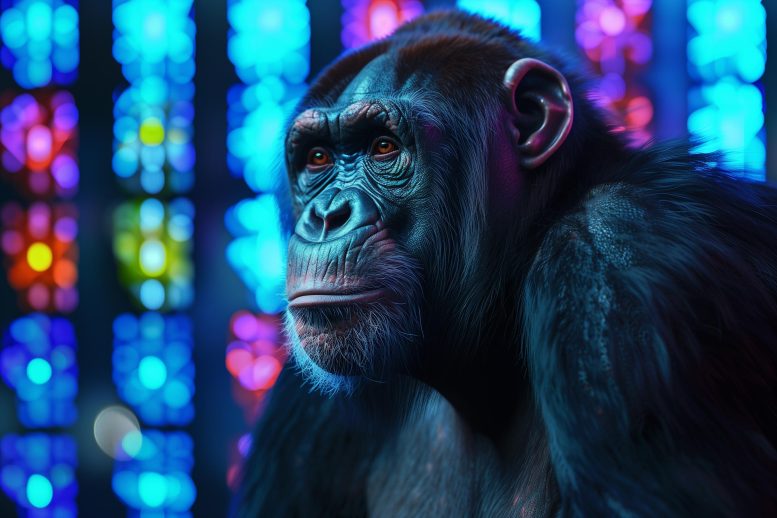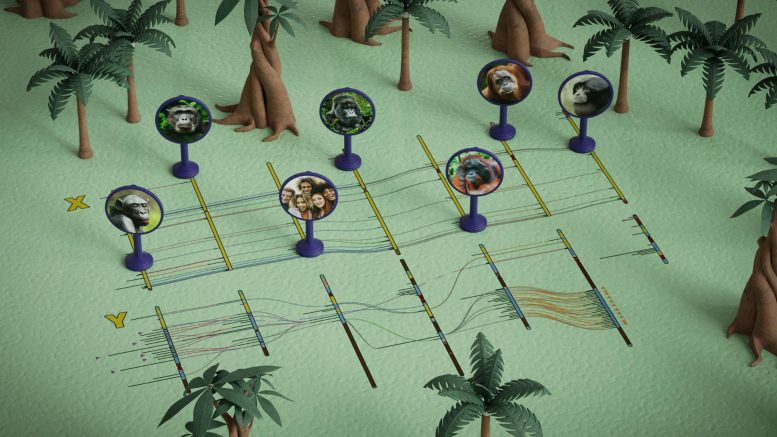
Researchers have sequenced the complete X and Y chromosomes of several great ape species, revealing significant evolutionary variations, especially in the rapidly evolving Y chromosome. This study, highlighting both stable and dynamic genomic regions, offers new insights into primate and human evolution, as well as the conservation of these endangered species. Credit: SciTechDaily.com
Complete X and Y chromosome sequences from six different primate species have been successfully mapped, revealing a rich diversity among these species and providing deeper insights into their evolutionary processes. This extensive genomic mapping highlights the unique and shared characteristics across these species, offering a clearer understanding of their evolutionary trajectories.
A team of scientists funded by the National Institutes of Health (NIH) has generated the first complete chromosome sequences from non-human primates. Published today (May 29) in the journal Nature, these sequences uncover remarkable variation between the Y chromosomes of different species, showing rapid evolution, in addition to revealing previously unstudied regions of great ape genomes. Since these primate species are the closest living relatives to humans, the new sequences can provide insights into human evolution.
The researchers focused on the X and Y chromosomes, which play roles in sexual development and fertility, among many other biological functions. They sequenced chromosomes from five great ape species, chimpanzee, bonobo, gorilla, and Bornean and Sumatran orangutans, as well as one other primate species that is more distantly related to humans, the siamang gibbon.
“These chromosome sequences add a significant amount of new information,” said Brandon Pickett, Ph.D., a postdoctoral fellow at the National Human Genome Research Institute (NHGRI), part of NIH, and an author of the study. “Only the chimpanzee genome sequence was fairly complete before this, but even that still had large gaps, especially in regions of repetitive DNA.”

Complete X and Y chromosome sequences from six primate species reveal species diversity and insights into evolution. Credit: Ernesto Del Aguila III, National Human Genome Research Institute
Advances in DNA Analysis
Analyzing these new sequences, the researchers estimated that 62 to 66% of the X chromosomes and 75 to 82% of the Y chromosomes are composed of repetitive DNA sequences. These sequences are much more challenging for scientists to characterize, and studying repetitive DNA has only become possible in recent years due to new DNA sequencing technologies and analysis methods.
The researchers compared the sequences of the ape chromosomes to the human X and Y chromosomes to understand their evolutionary histories. Like the human X and Y, the great ape Y chromosomes have far fewer genes compared to the X chromosomes. The researchers also used a computational method called alignment, which indicates regions of the chromosome that have stayed relatively the same over the course of evolution, revealing the effects of different evolutionary pressures on different parts of the genome.
The researchers found that over 90% of the ape X chromosome sequences aligned to the human X chromosome, showing that the X chromosomes have remained relatively unchanged over millions of years of evolution. However, only 14% to 27% of the ape Y chromosome sequences aligned to the human Y chromosome.
Surprising Variations in Y Chromosomes
“The extent of the differences between the Y chromosomes of these species was very surprising,” said Kateryna Makova, Ph.D., a professor at Pennsylvania State University and leader of the study. “Some of these species diverged from the human lineage only seven million years ago, which is not a lot of time in terms of evolution. This shows that the Y chromosomes are evolving very fast.”
A notable difference among the primate Y chromosomes is their length. For example, the Y chromosome from the Sumatran orangutan is twice as long as the gibbon’s Y chromosome. Variation in the number and types of DNA repeats accounts for some of the differences in chromosome lengths.
One type of repeat is called a palindrome, a DNA sequence which contains inverted DNA repeats. DNA palindromes are similar to language palindromes such as “racecar” or “kayak,” in which the letters in the first half of the word repeat in reverse in the second half of the word, so the sequence of the letters is the same forwards and backwards. However, the DNA palindromes can be over one hundred thousand letters long.
Unique Gene Variations and Future Research
The researchers found that the DNA palindromes on the primate X and Y chromosomes almost always contain genes, which repeat in many copies along the length of the chromosome. Most genes in primate genomes have only two copies, one on each chromosome in a pair. Researchers suspect that having many copies in these palindromes helps to protect genes, especially on the Y chromosome. Since there is typically only one Y chromosome per cell, if a gene on the Y chromosome is damaged, there is not another chromosome with a copy of the gene that can be used as a template to repair the damage.
“Having these genes in palindromes is like keeping a backup copy,” said Adam Phillippy, Ph.D., a senior investigator at NHGRI and senior author of the study. “We know that many of these genes are performing important functions, and so we expected to see the same genes in palindromes across different species, but this doesn’t seem to be the case.”
The researchers studied several groups of genes contained within the palindromes, many of which play roles in sperm production and are thus important for fertility. While palindromes were found on all the primate Y chromosomes studied, the specific palindrome sequences and the genes contained in these palindromes were often distinct for each species.
“There may be even more variation we’re not yet seeing,” said Dr. Phillippy. “On the human Y chromosome, some genes can vary in number between individuals. For each of these other primate species, we’re only looking at a single individual. We don’t know what the rest of the population looks like yet and what other variations we might find.”
“However, we have some insights from prior work by our group that suggests extensive variation in the number of copies of Y chromosome genes in humans and other apes,” Dr. Makova added.
These great ape chromosome sequences also resolve the sequences of another type of repeat called a DNA satellite, which is a large stretch of repeating sequence. Among the great ape chromosomes, the researchers identified several previously unknown, species-specific satellite sequences.
These sequences provide important insights into great ape genomes, as DNA satellites are present across the genome. Specifically, they are concentrated near the ends of chromosomes, called telomeres, and in another region called a centromere, which helps the chromosomes organize during cell division. The centromere sequences of these species were completely unknown before this study and another recent research effort conducted by many of the same researchers.
“Having these satellite sequences from great apes open up new territory to explore,” said Dr. Makova, “and similar to our other findings about the Y chromosome, we can see that the centromere of the Y chromosome is highly dynamic.”
Implications for Conservation and Understanding Evolution
These chromosome sequences can help researchers study the evolution of great apes, including humans. The researchers are currently working to describe the entire genomes of these great ape species, but even alone, the X and Y chromosome sequences offer many insights, especially about the evolutionary forces on the Y chromosome that contribute to its rapid evolution.
One factor is that there is typically only one Y chromosome per cell, which leads to accumulating changes to the DNA sequence. Another evolutionary force, Dr. Makova said, is a phenomenon known as male mutation bias. Compared to egg production, sperm production involves more DNA replication. With each replication, there is a chance that the DNA sequence changes. This affects all chromosomes but is particularly impactful for the Y chromosome.
Another potential factor is having a small population size, which can influence evolutionary rates. Not only do these ape species have limited populations in the wild, but the Y chromosomes are only present in half the population, further limiting the effective population size of this particular part of the genome.
“It’s important to remember that these great ape species are all endangered,” said Dr. Makova. “Not only can we learn about human evolution from these sequences, but we can apply what we know about their genomes and human genomes to better understand the biology and reproduction of these endangered species.”
Reference: “The complete sequence and comparative analysis of ape sex chromosomes” by Kateryna D. Makova, Brandon D. Pickett, Robert S. Harris, Gabrielle A. Hartley, Monika Cechova, Karol Pal, Sergey Nurk, DongAhn Yoo, Qiuhui Li, Prajna Hebbar, Barbara C. McGrath, Francesca Antonacci, Margaux Aubel, Arjun Biddanda, Matthew Borchers, Erich Bornberg-Bauer, Gerard G. Bouffard, Shelise Y. Brooks, Lucia Carbone, Laura Carrel, Andrew Carroll, Pi-Chuan Chang, Chen-Shan Chin, Daniel E. Cook, Sarah J. C. Craig, Luciana de Gennaro, Mark Diekhans, Amalia Dutra, Gage H. Garcia, Patrick G. S. Grady, Richard E. Green, Diana Haddad, Pille Hallast, William T. Harvey, Glenn Hickey, David A. Hillis, Savannah J. Hoyt, Hyeonsoo Jeong, Kaivan Kamali, Sergei L. Kosakovsky Pond, Troy M. LaPolice, Charles Lee, Alexandra P. Lewis, Yong-Hwee E. Loh, Patrick Masterson, Kelly M. McGarvey, Rajiv C. McCoy, Paul Medvedev, Karen H. Miga, Katherine M. Munson, Evgenia Pak, Benedict Paten, Brendan J. Pinto, Tamara Potapova, Arang Rhie, Joana L. Rocha, Fedor Ryabov, Oliver A. Ryder, Samuel Sacco, Kishwar Shafin, Valery A. Shepelev, Viviane Slon, Steven J. Solar, Jessica M. Storer, Peter H. Sudmant, Sweetalana, Alex Sweeten, Michael G. Tassia, Françoise Thibaud-Nissen, Mario Ventura, Melissa A. Wilson, Alice C. Young, Huiqing Zeng, Xinru Zhang, Zachary A. Szpiech, Christian D. Huber, Jennifer L. Gerton, Soojin V. Yi, Michael C. Schatz, Ivan A. Alexandrov, Sergey Koren, Rachel J. O’Neill, Evan E. Eichler and Adam M. Phillippy, 29 May 2024, Nature.
DOI: 10.1038/s41586-024-07473-2









How exactly one species can descend from another — if the two have different number of chromosomes?
Do you doubt the research without having read the paper, or are you asking out of curiosity?
Populations (species) do not descend from another but they spilt and diverge – say, if the population is found on opposite sides of an uncrossable river. That’s how chimps evolved north of and bonobos south of the Congo river.
As for chromosome we all evolved from prokaryotes that typically had one chromosome. (But they have variation too.) The chromosome number obviously can and have changed, and we find individual populations differing chromosome numbers. The – diploid, having two complete genome sets n – red howler monkey have the karyotype (chromosome number) 2n = 47, 48, or 49. That doesn’t hinder descent from parents.
If we take apes specifically humans have 46 chromosomes, whereas chimpanzee, gorilla, and orangutan have 48. An obvious hypothesis is that two chromosomes fused in humans, explaining the 2n=48 to 2n=46 rearrangement. On a smaller scale we can note that quite a few people have 45 chromosomes: “Robertsonian translocation (ROB) is a chromosomal abnormality where the entire long arms of two different chromosomes become fused to each other. It is the most common form of chromosomal translocation in humans, affecting 1 out of every 1,000 babies born.[1] It does not usually cause medical problems, though some people may produce gametes with an incorrect number of chromosomes, resulting in a risk of miscarriage.” [Wikipedia]
For the test of our hypothesis and how it fared, let me cite another paper that studied this evolution from the common ancestor between australopithecines/humans and chimps/bonobos:
“This major karyotypic difference was caused by the fusion of two ancestral chromosomes to form human chromosome 2 and subsequent inactivation of one of the two original centromeres (Yunis and Prakash 1982). As a result of this fusion, sequences that once resided near the ends of the ancestral chromosomes are now located in the middle of chromosome 2, near the borders of bands 2q13 and 2q14.1. For brevity, we refer henceforth to the region surrounding the fusion as 2qFus. Two head-to-head arrays of degenerate telomere repeats are found at this site; their head-to-head orientation indicates that chromosome 2 resulted from a telomere-to-telomere fusion (Ijdo et al. 1991). Furthermore, cross-hybridization between 2qFus and various subtelomeric regions has been observed by fluorescence in situ hybridization (FISH) (Ijdo et al. 1991; Trask et al. 1993; Hoglund et al. 1995; Martin-Gallardo et al. 1995; Ning et al. 1996; Lese et al. 1999; Ciccodicola et al. 2000; Park et al. 2000; Bailey et al. 2002; Martin et al. 2002).” [Genome Res. 2002 Nov; 12(11): 1651–1662.
“Genomic Structure and Evolution of the Ancestral Chromosome Fusion Site in 2q13–2q14.1 and Paralogous Regions on Other Human Chromosomes”.
Yuxin Fan, Elena Linardopoulou, Cynthia Friedman, Eleanor Williams, and Barbara J. Trask.]
That’s plenty of evidences that align to let the hypothesis survive (for now)!
This may need a more understandable description (and a spell correction!): “Populations (species) do not descend from another but they spilt and diverge – say, if the population is found on opposite sides of an uncrossable river.”
To understand species divergencies we need population genetics, which is the modern way of filling in the loose framework suggested by “descent with variation”. Fact, species splits are also descents with variation but we are interested in more than just evolution within a single population where every individual (in humans, say) are genetically different. So we want to study the divergencies that takes place on longer time scales after populations have been geographically separated by some mechanism (migration, say). Population genetics is uniquely suited to handle the different situations and time scales, so that is the core of modern evolutionary theory.